Flushing the Engine
- Nils Willner
- Aug 30, 2022
- 7 min read
If your car is +15 years old, has +150k km on the clock, consumes engine oil, has excessive blow-by or shows some carbon buildup from the inside, it can be a good idea to perform an engine flush additionally to the oil change. This is done via a cleaning agent that is filled into the engine oil and helps dissolve sludge from the inside. The agent breaks down all the deposits and sludge so it will come out with the old oil. If your engine is really dirty from the inside, the engine flush can actually have a really strong cleaning effect, leading to better engine performance afterwards. It improves the hydraulic function of valve timing systems and other oil-actuated switches and valves. An engine flush is most beneficial with Diesel engines since they produce a lot of soot and darken the oil quickly. Especially old diesel engines build up a lot of deposits over time.
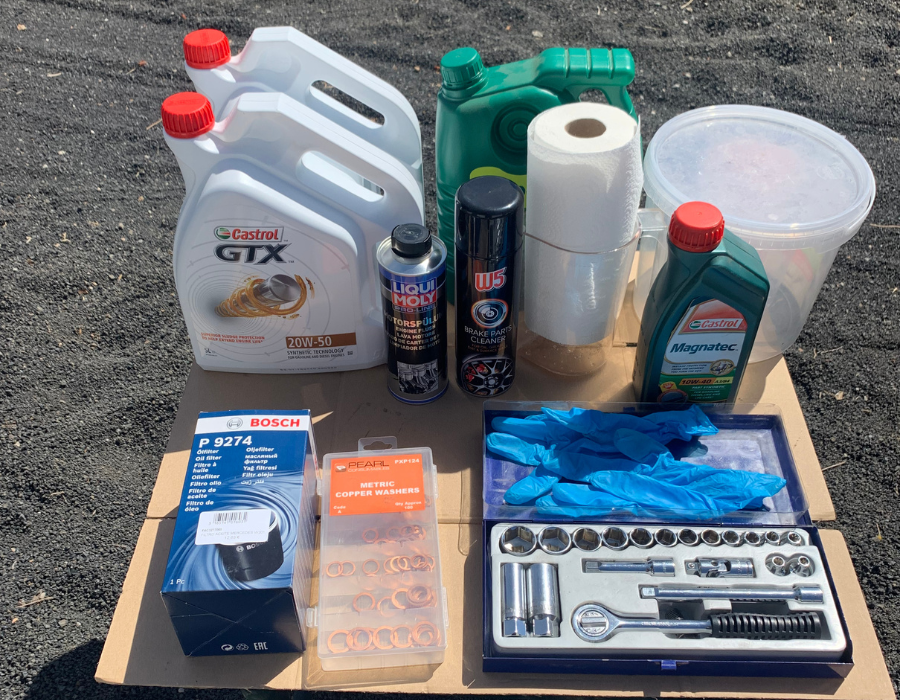
Considerations
Before performing an engine flush, consider the following: An engine flush will break off heavy carbon buildup, which can clog oil passageways and oil actuators, especially if they have super-tiny caveats such as hydraulic valve lifters. If the engine is extremely dirty and filthy, it might kill it. But in this case, you probably have other problems already. If the oil was regularly changed with quality products, a flush might be unnecessary because modern oils have already detergents in them. Also, keep in mind that an engine flush can be riskier with these points:
Complex variable valve timing systems
Modern high-performance engines
Turbo- & supercharged engines
Excessively dirty engine
Not suitable for motorcycles with wet clutches
However, Liqui Moly Flush recommends its flush agent for turbocharged engines, variable valve timing systems, and vehicles with a timing belt running in oil. It was also tested safely with cars that have catalytic converters and diesel particulate filters (DPF).
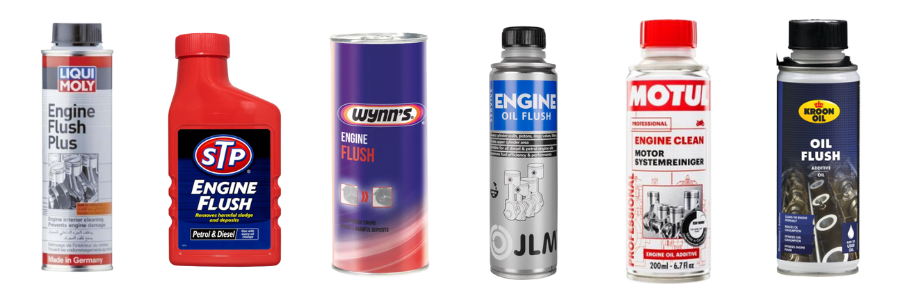
Preparation
Before you flush the engine, make sure you have these items ready:
High-quality engine oil with the right viscosity (Classic Car Engine Oils)
No-name brand engine oil to flush (For example Amazon Essentials Oil)
Quality engine flush agent (Liqui Moly, STP, Wynns or any quality product)
New oil filter & copper crush washers / o-rings
New drain plug with integrated magnet
Catch tray and funnel
Paper towels and latex gloves
Engine or brake cleaner
Ratchet set
Frist Flush
First, break open the oil sump drain plug and drain about 0.5 litres of engine oil so you can replace it with the engine flush agent. Normally, 500mL of the agent is sufficient for up to 5 litres of oil volume meaning that an inline 4 - 6 cylinder engine usually needs one bottle and cars with bigger engines such as V6 - 12 aggregates need two bottles. Tighten the plug again and fill in the cleaning agent. Turn on the engine and let it idle for about 15 minutes. Note that engine flush will decrease the viscosity index of your engine oil. Don't drive the car because this could lead to a rupture in the oil film and damage bearings and other engine parts. I do rev it to about 1'500 RPM to distribute the oil to all systems. Turn off the engine, let it cool down for 5 minutes and then drain the oil completely. If there is an oil cooler, you can also open one of the lines and drain it.
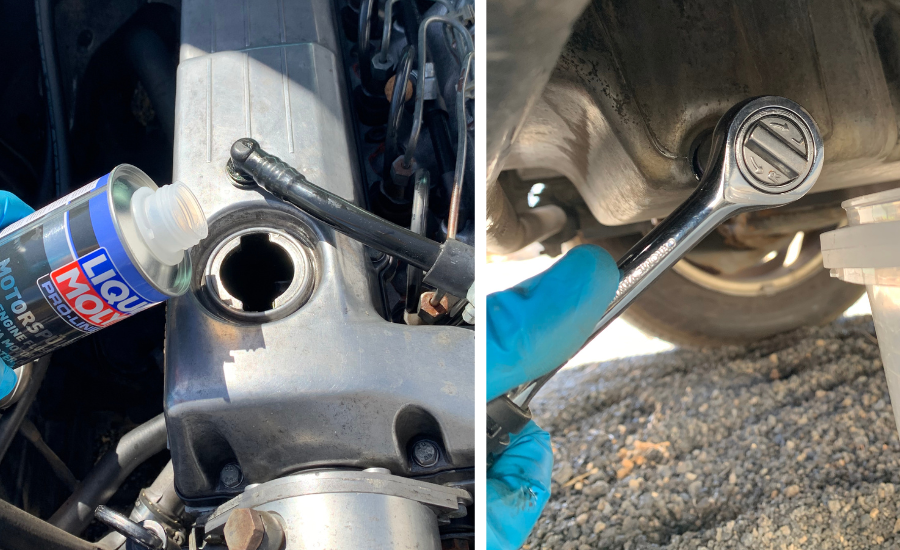
Second Flush
Put the drain plug back in and tighten it with the ratchet. Fill the engine up with a basic low-viscosity oil to thoroughly flush the old oil and cleaning agent from the system. I use a cheap and readily available 10W40 (you can also use a 5W20 or 5W30) no-name oil for the second flush. Fill in 5/6 of the needed volume and make sure that the oil level is at least touching the minimum mark. Let the engine run for about 5 minutes and monitor the oil level and pressure. Then drain the oil again. Most people (even garages) don't do a second flush with engine oil, but in my opinion, there will be a lot of sludge and remainders of the agent left in the pipes, filter housing and oil cooler. It is good practice to flush the engine with cheap engine oil. The amount of work is the same but you'll spend an extra $20 for a good consciousness and a job professionally done.
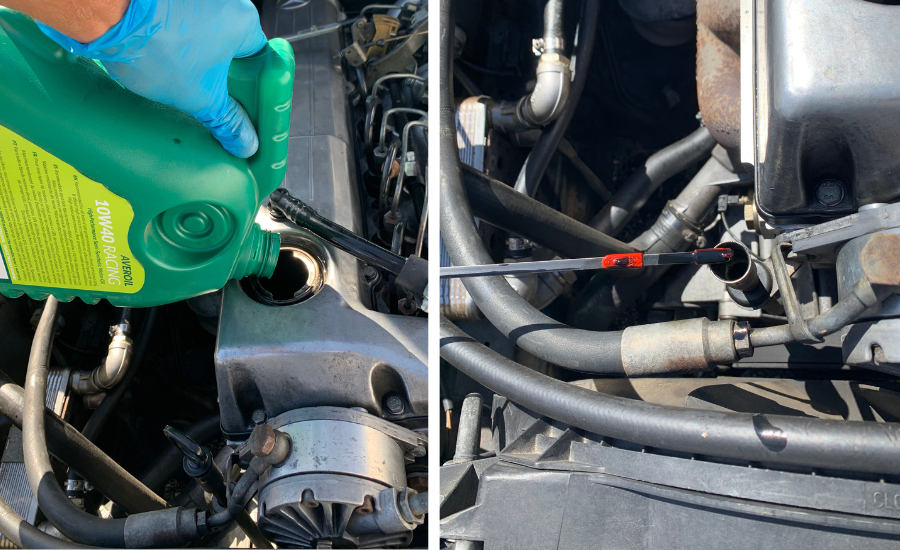
Oil Filter Change
While you are waiting for the second flush to completely drain, start changing the oil filter. If you do an engine flush, replacing the oil filter is mandatory because it will trap a lot of old oil inside of it. Only use high-quality and branded oil filters because the cheap ones have thinner paper-filter material and deteriorate way faster. Cheap filters don't provide the same protection as expensive ones do. I always buy a Bosch or original Mercedes oil filter and stay away from eBay or amazon ones. The last thing you want is dirty oil circulating in the engine due to a bad oil filter. Place a lot of paper towels around the oil filter area and have a plastic tray nearby where you can drop the oil filter into. When the old filter is removed, compare it to the new one so you are 100% certain that it is the same model.
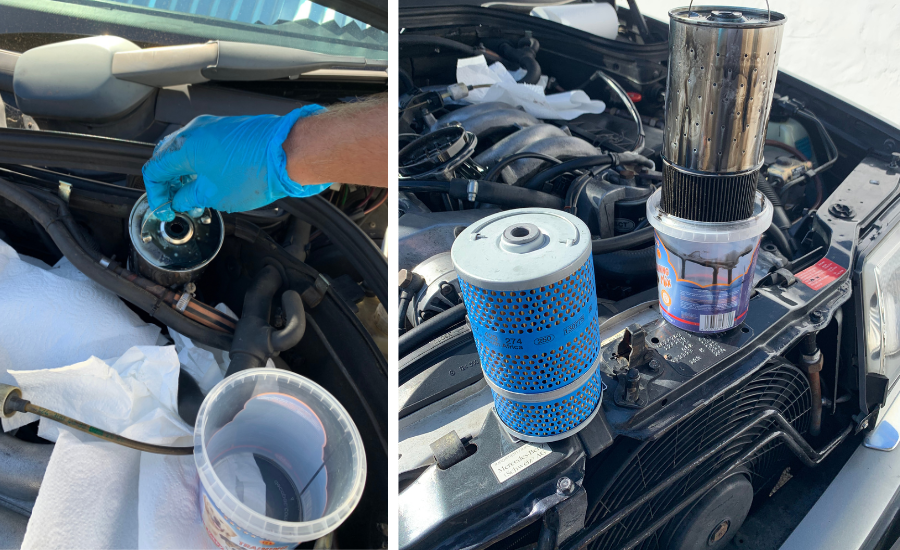
Oil Filter Change
When installing the new filter, apply some new engine oil onto the o-ring, so it won't stick to the engine block the next time you change it. Only hand-tighten it if you have a metal case style filter and don't use any tools. But give it a firm twist. If you have a cartridge-style filter, make sure you replace all o-rings and copper crush washers and torque the bolts to spec. I always replace all the o-rings and copper washers.

Drain Plug Change
It is also a good practice to replace the drain plug since they are often damaged already due to frequent opening and tightening. The corners are often rounded and the seat where the crush washer sits is scored. Also, I think it is very important to replace it with a magnetic drain plug. An engine always has some wear, especially an old one. Metal particles and fragments can come off bearings during a cold start, and they will then circulate in the oil system. You can catch them with a magnet and remove them with the next oil change. It sounds unnecessary, but you wouldn't believe what I already pulled out of engines with the magnetic plug: splinters, washers, small debris, bolts, screwdriver bits etc. As you can see in the photo, there is already a small amount of really fine metal flakes on the magnetic plug. On my automatic transmission oil pan, I have a series of Neodymium magnets attached to the underside of it to catch metal debris.
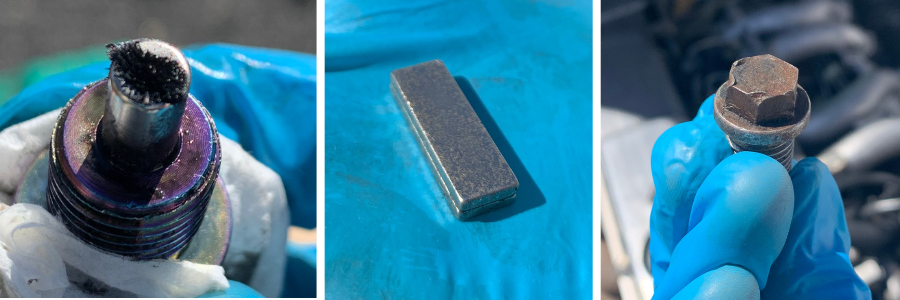
The Right Engine Oil
This article is not specifically about finding the best engine oil. Please refer to the article Classic Car Engine Oils. You can find this information and further considerations in my book too. The most important thing with engine oils is the right viscosity index. You can check your owner's manual and cross-check it with SAE tables to match the requirements and climate temperatures. Also, if your engine is smoking or suffers from low performance and low compression, I would recommend bumping up the warm SAE rating by 10 points. Because of this, I use 20W50, which is a heavy oil but very stable and resilient to heat, pressure and fuel contamination. Also, I always buy at least semi-synthetic engine oil since it lasts longer and doesn't oxidise and break down so quickly as mineral oil. If you have a turbocharger, this is a must.
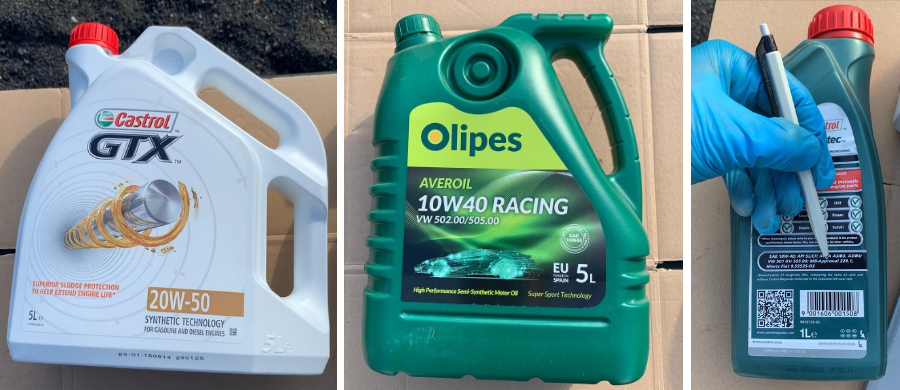
Filling Engine Oil
Install a new copper crush washer or o-ring on the drain plug and then tighten it to torque spec. Some people heat up the old copper washer and reuse it, which is absolutely fine as long as there are no dents in it. Don't reuse aluminium washers, though. Aluminium washers can only be crushed once and are non-reusable. Also, clean the oil pan and drain plug thoroughly with brake cleaner so you will spot possible leaks quickly later on. I like to see the oil pan spotless at all times because it is the lowest point on an engine. Any oil leak from the engine will eventually become visible at the pan because the oil is flowing down to the lowest point and then drips from there onto the road. Once everything is back in place, you can fill in the new engine oil.
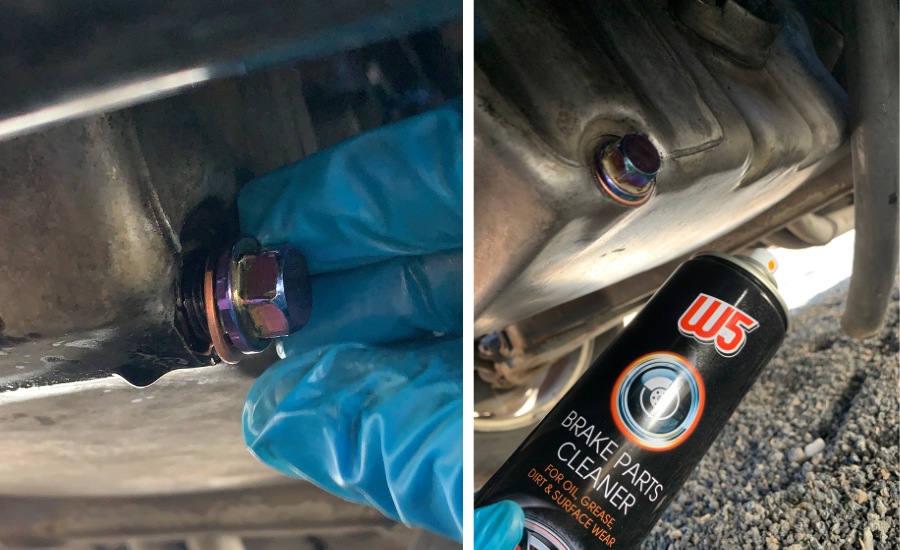
When filling the new oil, only pour in 5/6, so you don't overfill. Switch on the engine and let it establish oil pressure. Once the oil level warning lamp turns off, switch off the engine, wait 5 minutes for the oil to flow back into the oil pan and check the dipstick. Pour in the rest of the oil if needed. Then, drive for about 5 miles and recheck the oil level afterwards. In my opinion, you can't really check the oil level too often. Every time I open the hood, I check the oil level. Many people never check their oil level, but the engine will deteriorate and get damaged quickly without sufficient oil. Oil is like blood; it is the most essential part of any combustion engine and keeps every shaft, bearing and piston moving smoothly.
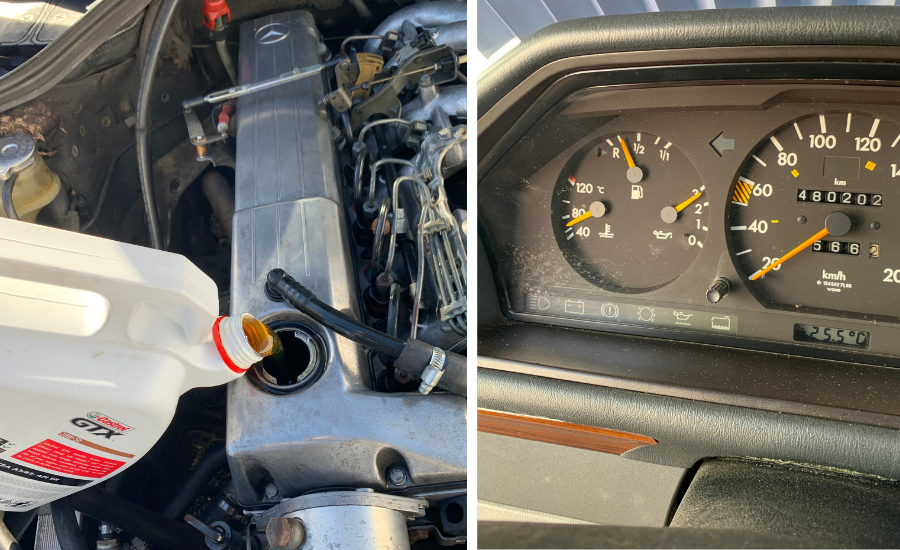
Correctly flushing the engine and changing the engine oil is just one of many essential things to do when taking care of your own car. In order to keep a classic car alive as long as possible, more maintenance and repair tasks need to be done correctly. You can find detailed instructions and explanations in my book:


Nils Willner
Nils is a Swiss-German engineer who is obsessed with old cars and engines. He is the author of "The Ultimate Classic Car Guide - How to Buy, Maintain & Repair Classic Cars" and the founder of EVC. His passion has always been with old cars and everything with wheels and engines.


Comments